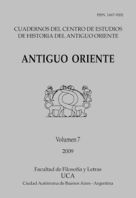Please use this identifier to cite or link to this item:
https://repositorio.uca.edu.ar/handle/123456789/7228| Título: | Poner el cuerpo. Mujeres y política estatal en Mari (Siglo XVIII a.c.) Putting the Body on the Line. Women and State Politics in Mari (XVIII Century BC) |
Autor: | Rovira, Leticia | Palabras clave: | EDAD ANTIGUA; POLITICA; MUJERES; CERCANO ORIENTE | Fecha de publicación: | 2009 | Editorial: | Pontificia Universidad Católica Argentina. Facultad de Filosofía y Letras. Departamento de Historia. Centro de Estudios de Historia del Antiguo Oriente | Cita: | Rovira, L. Poner el cuerpo. Mujeres y política estatal en Mari (Siglo XVIII a.c.) [en línea]. Antiguo Oriente: Cuadernos del Centro de Estudios de Historia del Antiguo Oriente. 2009, 7 Disponible en: https://repositorio.uca.edu.ar/handle/123456789/7228 | Resumen: | Abstract: Women and men are subjects defined both by their physical-natural reality and their socio-cultural environment. In this way they are reified, and many such examples can be found throughout history. We are interested in the situation of women in Ancient Mesopotamia, particularly the daughters of Zimrî-Lîm, king of the city of Mari, the archaeological site of Tell Hariri, modern Syria, during the 18th century BC. Zimrî- Lîm made marriages a policy of the state. He himself married foreign women and married their joint daughters to other important kings as well. This marital policy was another, more extended, way of dominion where women were a nexus between Mari and other states. In this paper, we will analyze the roles which were assigned and developed by royal women from a political level via a comprehensive approach. These women are presented generally as political objects, though, in extreme cases also they were taking forward actions as subjects and by it they were visualized as “the other,” the foreigner and, in some cases, the enemy. Resumen: Mujeres y hombres se conforman como sujetos delimitados en cuanto a su realidad físico-natural pero también según su entorno socio-cultural. Ello da lugar, muchas veces, a la cosificación de los individuos y la historia nos brinda variados ejemplos. En relación con esto, el caso concreto que nos interesa indagar se sitúa en la antigua Mesopotamia del siglo XVIII a.C. y se refiere a las hijas de Zimrî-Lîm, rey de la ciudad de Mari, actual sitio arqueológico de Tell Hariri en Siria. Este monarca se vinculó en matrimonio con mujeres extranjeras y unió a sus hijas a reyes foráneos. Tal política matrimonial formaba parte de una más amplia política estatal de dominio, donde la entrega de una mujer forjaba un nexo entre Mari y otros estados. Nuestro objetivo es analizar los roles asignados y desarrollados por esas mujeres de palacio desde el plano político a través de una mirada relacional. Ellas nos son presentadas generalmente como objetos políticos, aunque, en casos extremos también llevaban adelante acciones como sujetos y por ello eran visualizadas, por sus consortes como un “otro”, un extranjero y, en algunos casos, hasta como un enemigo. |
Cobertura Espacial: | MESOPOTAMIA SIGLO XVIII A.C. |
URI: | https://repositorio.uca.edu.ar/handle/123456789/7228 | ISSN: | 1667-9202 | Disciplina: | HISTORIA | Derechos: | Acceso Abierto | Fuente: | Antiguo Oriente: Cuadernos del Centro de Estudios de Historia del Antiguo Oriente. 2009, 7 |
| Appears in Collections: | AO - 2009 vol. 7 |
Files in This Item:
| File | Description | Size | Format | |
|---|---|---|---|---|
| poner-el-cuerpo-mujeres-politica.pdf | 462,68 kB | Adobe PDF |  View/Open |
Page view(s)
261
checked on Apr 30, 2024
Download(s)
266
checked on Apr 30, 2024
Google ScholarTM
Check
This item is licensed under a Creative Commons License

